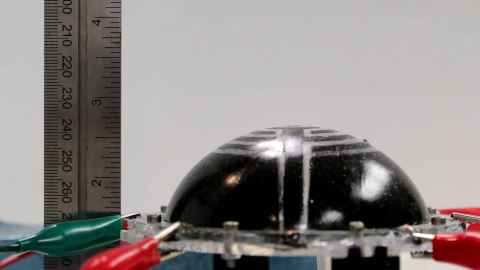Soft inflatable robots for outer space
18 April 2019
If robots are going to change life on earth, we could expect them to transform life in outer space, at least the lives of people we send into space.

Yet it is also phenomenally expensive to send anything into space, and the heavier the pricier.
This is what prompted Joseph Ashby at the Auckland Bioengineering Institute (ABI) to develop a new type of inflatable robot; one that is light, doesn’t take up much space, and can be inflated and put to work in space.
"It takes thousands of dollars to launch even a single kilogram into orbit," says Mr Ashby. "We wanted to develop a way to replace current technology with lighter smart-materials and then combine them with inflatable structures."
The technology used in Ashby’s inflatable robots is a novel use of years of research expertise developed at the ABI’s Biomimetics Lab, led by Associate Professor, Iain Anderson.
That is, dielectric elastomer transducers (DETs).
DETs were initially invented in 1880 by Wilhelm Röntgen, who sprayed electrical charge onto a strip of rubber (which doesn’t conduct electricity) and made it move.
The technology was developed further in the 1990s by scientists at Stanford research International (SRI), who used squishy electrodes on each side of a rubbery material.
Essentially, it is a method that relies on electrical fields to drive the oppositely charged particles together and the like-charged particles apart, and in the process manipulates the shape and movement of the non-conducting rubbery material.
"We discovered we were pretty good at getting the electronics to talk to the rubbery stuff,” says Assc. Prof. Anderson. "That became our strong point."
They also found that could also use DETs as capacitive sensors to measure movement, which led to the development of spin-out company, StretchSense, established with two of Anderson’s former PhD students, Dr Ben O'Brien and Dr Todd Gisby.
StretchSense is now a global supplier of soft, squishy sensors that can be embedded into the fabric of garments, and used to monitor movement. By inserting the sensors into a glove, for example, they can monitor the movements of fingers and thumbs.
We discovered we were pretty good at getting the electronics to talk to the
rubbery stuff
What goes around comes around. StretchSense is currently funding Mr Ashby’s research into space robots, in which he combines the soft materials used by the company and integrates them with inflatable structures to form the basis for his soft, low mass robots.
As they are made entirely of soft materials, DET structures can be inflated similarly to a balloon, says Mr Ashby.
"This means that they can form large structures when deployed, but can be packed into small spaces when they’re not."
While stretch sensors are mainly used for wearable technology applications, NASA is also exploring using the strain-measuring technology in space – that is, using it to monitor the inflatable fabric-based space modules NASA is developing, designed to expand in space to create areas for astronauts to live and work in.
Mr Ashby says that while his research into space robots has yielded promising results, the robots are at very early stages of development. Space, for both astronauts on space missions as well as DET-based robots requires overcoming a number of complex environmental conditions.
"We’re now working on developing shielding methods to protect our robots from the harsh space environment," he says.
Inflatable dielectric elastomer robots for space was published in SPIE Digital Library.
Want to help us make a difference?
There are many ways you can make a difference and support the Auckland Bioengineering Institute - you can make a donation or bequest, or even subscribe to our newsletter.